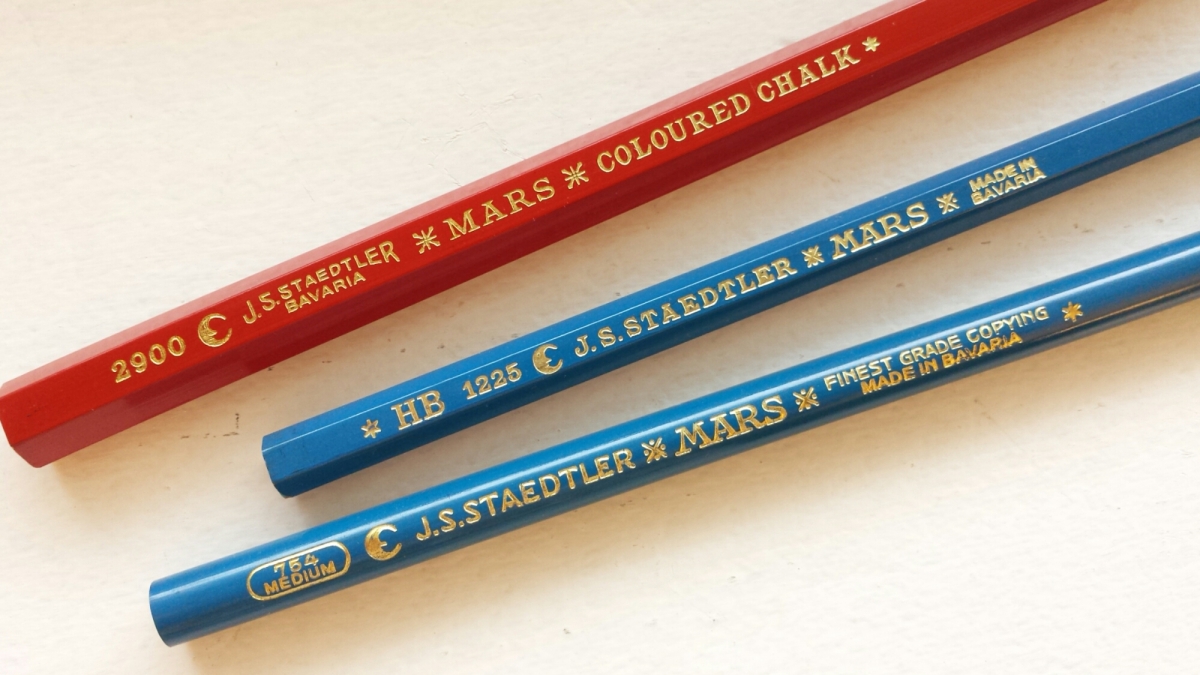The other day I received a delightful package from France.
I wonder how these three particular pencils came to be packaged together. The box seems to be original to these pencils, despite the fact that it doesn’t carry the Staedtler logo, because the three pencils fit so snugly inside. Maybe it was a gift or sample package of some kind?
The crisp gold letters and the vivid paint, combined with the lead quality, show that German pencilmakers were really at the top of their game. I love the exquisite lettering, in particular what I privately think of as the “rainbow over Bavaria”:
The way they are sharpened is also very interesting. The shapes are all different (and I think all are factory-sharpened):
The Mars 1225 is known as the precursor to the Mars Lumograph. It was produced from 1908 to 1930, after which the Lumo took over. (I don’t know exactly when the imprint changed from “Made in Bavaria” to “Made in Germany”. )
Until very recently, I had made the mistake of judging all pencils based on my personal tastes; specifically, how a pencil performed for someone with a moderate to light grip, who wrote quick, loose cursive on lightly coated paper. But as I get to know more and more pencils, I realize that many of them (especially older ones) are made with a specific purpose in mind, and that is the standard by which they should be judged. If I haven’t been totally satisfied with the Lumograph in the past, it is because the Lumograph wasn’t made for ordinary people like me. Instead, we should ask (as with all draughting pencils worth their salt)*:
- Does the pencil make a crisp, even line, unvarying in width, when ruled from one end of the paper to the other?
- Does the graphite stay where it should, or does it smudge and soil the paper?
- Is the lead break-resistant?
- Are the lines opaque enough to allow for clear reproductions?
And this is where the Lumograph delivers. Talking about this pencil, I sorely feel the lack of an architectural or engineering background – the only pencils I am probably qualified to judge are the “general writing” pencils. Dear Lumo, I hardly knew you, let’s start over again!
*I am indebted to the journalist Tsuchihashi-san, especially to his book on long-selling stationery items, and Gunther for the insights contained in this post. Gunther’s blog is a treasure trove of information, particularly on Staedtler history. I strongly encourage anyone interested in Mars pencils to read through his posts (and Google does a decent job of translating from German to English).







The Lumograph is great. I love it, especially in F (as long as you keep it sharpened to a fine point) as it will keep the point so well. Kent thought of it as “The Standard” ( http://www.pencilog.com/2009/05/staedtler-mars-lumograph-100-standard.html ).
the presharpened third pencil looks not too different to a modern one, but the second one is the most fascinating one – it looks great!
LikeLiked by 1 person
It is interesting how the Lumograph retains its reputation as the standard-setter regarding pencil grades. They also seem more available anywhere, at least I’ve felt that was the situation back home and in Canada.
The second pencil (Mars 1225) seems to have been sharpened with a “shaver” such as this. As you say, the way the round copying pencil is sharpened is more familiar – my 2390 and old Stenofixes came like that.
LikeLike
Thank you for showing this set and for the beautiful photos! I too think that it is a sample package.
The concave factory-sharpening of the Lumograph is beautiful! – I don’t know if there has ever been a 1225 “Made in Germany” since the early 2886 (without the lacquer cap) had also “Made in Bavaria” on them. – The different signs are interesting: A star consisting of four crossed lines, a dotted saltire and a six-pointed star. I wonder if they had a meaning or were simply decoration!
And thank you for your kind words, Sola – I feel honoured :-)
LikeLike
Oh, you are very welcome :) As for the “Bavaria”: it says that the Free State of Bavaria became part of the Weimar Republic in 1919, so I guess they held on to the “Bavaria” name for a few more years before changing to “Germany”? Just a guess. And I love the six-pointed sharpening too :)
LikeLike